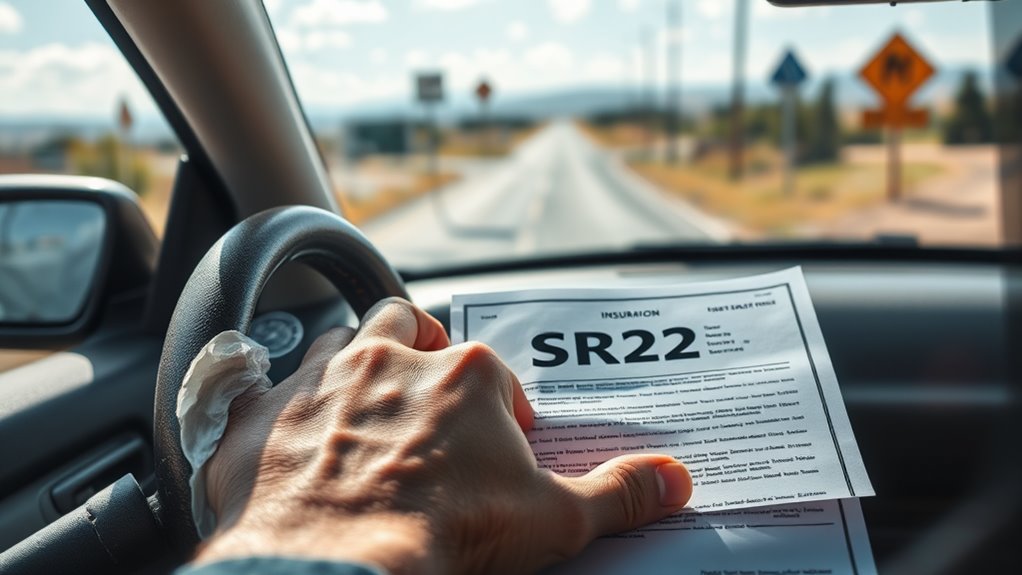
If you’ve faced serious traffic violations, you might be required to obtain an SR-22 bond. This document isn’t just a formality; it reflects your financial responsibility and can notably impact your driving privileges. Understanding when an SR-22 is necessary and how it affects your insurance can save you from costly mistakes. What you might not realize is how this requirement can alter your financial landscape in the long run.
Key Takeaways
- An SR-22 bond verifies financial responsibility for driving and is required for high-risk individuals.
- It is often mandated after DUI/DWI convictions or driving without insurance.
- SR-22 filings confirm compliance with state minimum liability limits and are managed by insurance providers.
- The duration for maintaining an SR-22 can range from one to five years, depending on the violation’s severity.
- SR-22 bonds may result in increased insurance premiums, often ranging from $400 to $1,000 annually.
Understanding SR-22 Bonds
When you need to demonstrate financial responsibility for driving, understanding SR-22 bonds becomes essential.

Understanding SR-22 bonds is crucial for demonstrating financial responsibility while driving.
These documents verify that you have adequate financial coverage for damages, especially in states allowing alternatives to auto insurance. Unlike traditional insurance, SR-22 bonds require a significant upfront deposit with the treasury, ensuring that funds are available in case of an accident. It’s important to note that an SR-22 is typically needed for individuals who have been flagged for driving without insurance or a valid license.
Importantly, the bond covers you personally, not just your vehicle, providing flexibility when driving different cars. Electronic filing facilitates quicker registration and license reinstatement, enhancing convenience.
Additionally, routine checks maintain the deposit’s adequacy, with the DMV receiving notifications of any changes. While not a substitute for insurance, SR-22 bonds serve as a viable option to meet financial responsibility requirements.
When Is an SR-22 Required?
Have you ever wondered under what circumstances an SR-22 becomes necessary? Typically, it’s required after a DUI or DWI conviction, often mandated for a minimum of 2-3 years, even for first-time offenders.
If you drive without valid insurance, especially after being caught operating an uninsured vehicle, you’ll also need an SR-22.
Multiple traffic violations, such as excessive speeding, can trigger this requirement for habitual offenders.
Additionally, if you cause an at-fault accident without insurance, proof of financial responsibility through an SR-22 is vital. SR-22 serves as verification of your compliance with Texas liability insurance laws.
Courts may order it as part of a sentence or for license reinstatement after revocation.
Failing to maintain the SR-22 can lead to further license suspension. Understanding these scenarios is important for compliance.
Filing Process for an SR-22
When you’re ready to file for an SR-22, start by gathering the required documentation, including your driver’s license, insurance policy, and any court documents.
Next, choose an insurance provider that can handle the SR-22 filing and confirm their submission process with the state agency.
Finally, make certain that you understand the timeline for submission and any potential delays that might affect your compliance.
Required Documentation and Information
To successfully file for an SR-22, you’ll need to gather specific documentation and information that demonstrate your compliance with state insurance requirements.
Begin by obtaining proof of minimum liability insurance coverage, as this is vital for your SR-22 filing. You may also need personal identification documents to verify your eligibility.
Additionally, gather vehicle information, which might be necessary in certain cases. Your driving record will play a significant role in determining the SR-22 requirements and associated costs, so have that ready.
Finally, keep any payment receipts for the SR-22 filing fees, as these may be required during the processing. Ensuring you have all this documentation will streamline your filing process and help avoid delays.
Insurance Provider Selection
Choosing the right insurance provider for your SR-22 filing is a critical step in guaranteeing compliance and managing costs effectively.
Start by evaluating policy eligibility; not all insurers offer SR-22s, especially for high-risk drivers. Consider how providers classify your risk, as this classification impacts your premiums and options.
Look for companies that specialize in high-risk insurance, as they may better accommodate your needs. Compare quotes from multiple providers to identify the most cost-effective option, accounting for potential premium increases and additional filing fees.
Confirm the insurer you choose can handle the SR-22 filing process efficiently and has solid customer support to assist you throughout the process. Making informed decisions here can greatly affect your financial and legal standing.
Submission to State Agency
Submitting your SR-22 to the state agency is an essential step in maintaining compliance and avoiding potential penalties. Here’s what you need to reflect on during the filing process:
- Electronic submission offers faster processing through AAMVA’s system.
- Required documentation includes a valid insurance policy and court notice.
- Processing timelines for electronic filings are typically 24-48 hours.
- State-specific protocols may require electronic-only submissions.
- Consequences of non-compliance can lead to automatic license suspension.
Ensure you follow these steps meticulously to prevent delays or rejections.
Costs Associated With SR-22 Bonds

While managing the costs associated with SR-22 bonds, you’ll encounter several key expenses that can greatly impact your finances.
First, you’ll face SR-22 filing fees, typically ranging from $25 to $50, but some states may charge up to $200 annually. Additionally, your insurance premiums will likely increase by $400 to $1,000 due to your high-risk classification.
You’ll need to maintain continuous coverage for 2-3 years, or up to 5 years for severe violations, to avoid state penalties. Prepare for potential license reinstatement fees and legal costs as well.
To mitigate these expenses, consider comparison shopping, taking defensive driving courses, or bundling policies to lower overall costs. Each of these strategies can help ease the financial burden.
Differences Between SR-22 and Insurance
When you consider an SR-22, understand that it serves as a verification form, proving you have the minimum required auto insurance to drive legally.
Unlike traditional insurance, which offers various coverage options, an SR-22 primarily guarantees your financial responsibility after certain driving violations.
This distinction highlights the role of an SR-22 as a compliance tool rather than a thorough insurance policy.
Definition of SR-22
An SR-22 is an essential document that serves as proof of minimum liability insurance coverage for high-risk drivers.
It’s vital to understand its specifics:
- SR-22 Filing Purpose: Filed with the state to verify minimum liability insurance.
- Not an Insurance Policy: It’s an add-on to your existing liability insurance.
- Required for High-Risk Drivers: Necessary for those with DUIs or multiple violations.
- Issued by State or Court: Ordered by courts or the department of motor vehicles.
- Term Duration: Usually mandated for several years depending on the offense.
Insurance Policy Coverage
Understanding the differences between SR-22 filings and standard insurance policies is essential for high-risk drivers.
An SR-22 isn’t an insurance policy; it’s a filing that verifies compliance with state requirements, necessitating adequate liability coverage. While standard insurance may include liability as part of its package, the SR-22 mandates this coverage for specific offenses, such as DUIs.
Additionally, maintaining an SR-22 often incurs higher costs due to administrative fees and the need for continuous coverage over typically three years. Each state has its regulations, influencing both the duration and financial implications.
Consequently, understanding these nuances helps you navigate the complexities of high-risk automobile insurance effectively.
Financial Responsibility Guarantee
While both SR-22 filings and standard insurance policies play essential roles in maintaining legal driving status, they serve distinctly different purposes in the domain of financial responsibility.
Understanding these differences is significant for any driver, especially those deemed high-risk.
- SR-22 is a state filing, not insurance.
- Insurance provides coverage, SR-22 confirms compliance.
- State-mandated for high-risk drivers.
- Insurers handle SR-22 filings and cancellations.
- SR-22 maintains minimum liability limits.
Essentially, an SR-22 demonstrates that you meet state minimum liability requirements.
It verifies your active insurance but doesn’t provide coverage like a typical policy does.
This distinction is imperative for maneuvering the complexities of legal driving obligations and ensuring compliance with state regulations.
SR-22 vs. FR-44: Key Distinctions
When maneuvering through the complexities of auto insurance requirements, it’s crucial to distinguish between SR-22 and FR-44 certificates, as they serve different purposes and come with varying stipulations.
An SR-22 is typically required for non-alcohol-related violations like reckless driving, verifying state minimum coverage. In contrast, an FR-44 is reserved for DUI/DWI convictions, demanding stricter liability limits, often double or triple the SR-22 minimums.
An SR-22 is for non-alcohol violations, while an FR-44 applies to DUI convictions with stricter coverage limits.
While SR-22 is recognized in most states, FR-44 is exclusive to Florida and Virginia. Both require insurers to file directly with the DMV, and non-compliance can lead to automatic license suspension.
Understanding these differences helps you navigate insurance requirements effectively, ensuring you’re compliant with state laws and avoiding penalties.

Impact of SR-22 on Insurance Rates
The requirement of an SR-22 can greatly impact your insurance rates, especially if it’s due to serious violations like DUIs or reckless driving.
Here are key factors influencing your premium increases:
- Nature of Offense: DUIs lead to higher rate hikes than minor infractions.
- Driving History: A clean record may help mitigate increases.
- Age and Location: Younger drivers or those in high-risk areas often face steeper premiums.
- Insurance Provider Policies: Each company has different risk tolerance levels.
- Local Regulations: State-specific laws can affect overall costs.
On average, SR-22s can raise your premiums considerably, with increases ranging from 20% to 187%, depending on your location and circumstances.
This can lead to a long-term financial burden.
Duration of SR-22 Requirements
Understanding the duration of SR-22 requirements is essential after facing serious driving violations that can affect your insurance rates.
Generally, states impose SR-22 mandates ranging from one to five years, depending on the offense’s severity. Most states require compliance for two to three years, while severe violations like repeat DUIs can extend the requirement up to five years.
For minor infractions, some states may only necessitate SR-22 coverage for one year. The duration starts from the offense or conviction date, and you must maintain continuous coverage; any lapse will reset the clock.
States actively monitor compliance through insurers, and courts can impose longer terms based on specific circumstances, ensuring you’re fully aware of your obligations moving forward.
Maintaining SR-22 Status
To maintain your SR-22 status, you need to guarantee consistent insurance payments to avoid lapses in coverage.
Regularly monitoring your policy status is essential, as any changes could jeopardize your compliance.
Staying proactive about these factors will help you navigate the complexities of SR-22 requirements more effectively.
Insurance Payment Consistency
Maintaining SR-22 status hinges on consistent insurance payments, as any lapse can lead to severe consequences. To guarantee you stay compliant, consider the following:
- Continuous coverage must meet state-specific liability thresholds.
- Insurers file your SR-22 directly with the state to confirm active status.
- Non-payment triggers DMV notifications, risking license suspension.
- Any lapse will require re-filing and additional fees to regain driving privileges.
- Persistent non-compliance could escalate your status to that of a habitual offender.
Monitoring Policy Status
Consistent insurance payments set the foundation for maintaining your SR-22 status, but monitoring your policy status is equally important.
Your state actively tracks SR-22 compliance, and any lapse in coverage can lead to severe penalties, including license suspension. Insurance companies file SR-22 forms on your behalf, but you must guarantee they maintain up-to-date coverage with the state.
Regularly verify that your insurer hasn’t reported any lapses, as states may utilize electronic filing systems for efficiency. Be mindful that the monitoring period varies, typically lasting between one to three years.
Staying proactive about your policy status not only helps you avoid fines but also safeguards your driving privileges as you navigate the SR-22 requirements.
What Happens After SR-22 Period Ends?
Once you’ve completed the SR-22 period, you’re no longer obligated to maintain this specialized insurance, which can be a relief for many drivers.
However, it’s essential to manage the shift carefully. Here’s what you need to take into account:
Managing the transition from SR-22 requires careful consideration and attention to your insurance needs.
- Confirm the end of your SR-22 with both your insurer and state DMV.
- Adjust your insurance coverage to reflect standard policies, potentially lowering premiums.
- Monitor your driving record to guarantee no further violations occur.
- Explore better insurance options that suit your needs post-SR-22.
- Be aware of any state regulatory changes that might affect your coverage.
Properly steering through these steps will help maintain your driving privileges and make sure your insurance needs are met effectively.
Frequently Asked Questions
Can I Cancel My SR-22 Before the Requirement Period Ends?
You can cancel your SR-22 before the requirement period ends, but it may lead to penalties like fines or license suspension. Always check your state’s regulations and confirm with your insurer to avoid complications.
What Happens if I Let My SR-22 Lapse?
If you let your coverage lapse, you risk license suspension, increased insurance rates, and potential fines. It’s crucial to maintain continuous coverage to avoid these costly consequences and guarantee your driving privileges remain intact.
Can I Switch Insurance Companies While Having an SR-22?
Switching insurance companies is like dancing between raindrops; you can do it without getting wet. Just guarantee you notify both insurers, maintain coverage, and file the necessary forms to keep your obligations in check.
Are There Penalties for Not Filing an SR-22?
Yes, there’re penalties for not filing an SR-22. You might face license suspension, hefty reinstatement fees, and increased insurance premiums. Additionally, non-compliance could lead to prolonged consequences on your driving record and future insurance options.
How Do I Know When My SR-22 Requirement Is Over?
To determine when your requirement ends, check your state’s DMV for specific regulations. Track the starting date linked to your offense or license suspension, and keep detailed records to guarantee compliance during this period.
Conclusion
In managing the winding roads of driving regulations, understanding your SR-22 bond is essential. Think of it as a lifeline—one that keeps you tethered to legal driving while you work to regain your standing. By maintaining continuous coverage and adhering to the requirements, you not only pave the way for a brighter future on the road but also steer clear of potential pitfalls. Once the SR-22 period ends, you can finally enjoy the open highway without the weight of restrictions.

